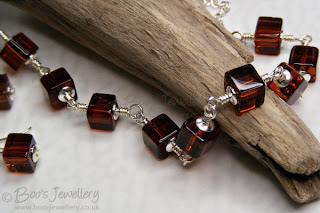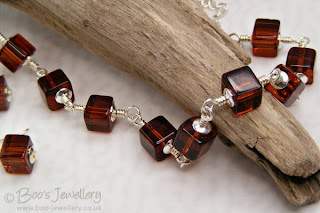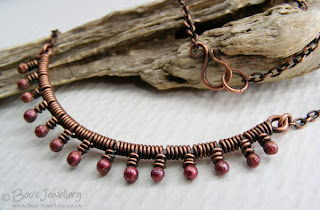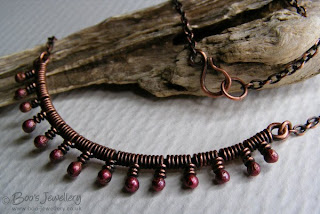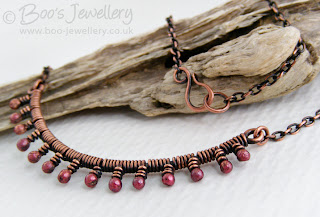When I first started selling my jewellery on-line, I went through a slow and agonising process trying to decide on how best to present items for sale - I started with buying a domain name in some hosting with the full intention of starting my own shop - initially using PayPal buttons to create a pseudo cart. I had sold greetings cards for a long time using this process and it had worked well, but the jewellery didn't quite work as well - I needed more than one photo per item and much more space for measurements, descriptions etc.

I did a lot of work putting pages together and trying layouts and organisation and it became clear very early on that this was going to be a very tedious process. I seriously needed to hone the workflow into something actually manageable. It takes a lot of work to photograph jewellery pieces, measure them, write a description and price them - often this part takes longer than it does to make the item. To then have to write code to put them on a web page and keep the site organised, took it beyond practicability - on top of a day job and time spent making too - which is the fun bit and consequently likely to suffer.
I'd bookmarked and been looking at the US based hand made venue site Etsy for some time, but hadn't realised that as a UK crafter I could also have a shop there, so putting some items on there gave me the chance to embed my Etsy mini shop (as seen here in brief form on the right) onto a basic portfolio page on my site and bought me some thinking time.

I'd visited and greatly admired an Australian jewellery store on-line. Their jewellery was elegant and expensive and their site gave just the right impression and worked really well - just what I had in my fantasy mind for my own - a page for each item, with multiple photos and nice easy navigation. I looked at the little credits at the bottom of the page and it said it was a Cubecart site.
Further investigation revealed that at the time there were three main cart systems of that style available largely free to use in the right web hosting packages - CubeCart, Zen Cart and OS Commerce. So I spent a great deal of time trying to find a host with them to try and I did try all three. CubeCart was head and shoulders above the others for me. At the time, it was the only one that allowed multiple photos per item and its methodology suited my requirements and skills by far the best.
I found that I could tweak the appearance myself by editing the standard graphics and editing the style sheets and thereby creating my own skin, based on one of the standard ones - this was a task within my capabilities. It also became evident that carts of this nature are highly customisable - there are a massive array of commercial skins and 'mods' to get them working how you want. It also became evident that the original Australian site that set me on this path was very heavily modded and I wasn't going to get something quite so elegant within my skill-set and budget.
I fully intended to buy a commercial skin once I'd satisfied myself that this particular cart was the right one for me - I needed to be sure I was making the right decision before I invested even more work. I chose a skin, but spent some time modding my own from one of the three that come with the cart as standard. I wanted to add some items to see how it worked in practice. I put together a finished enough looking site and asked a few friends and family to test it for me, showing them the final design I was aiming for. Every single one of them preferred the working site appearance to the skin I had picked out, so I just stuck with what I had and spent the time polishing that up some more instead.

So that was about 15 months ago now. I've gradually modded the site to get it functioning more how I want it and I still have a lot more ideas to put into practice as the budget will allow. I find the site easy to work with - it might not be as good for other products or other methodology, but I have been thrilled with how it works for me. I suspect if I were significantly busier and had more staff, it might not be the best, but for
me and my workflow, it has been absolutely ideal.
I now maintain
both my own shop and a
sister one on Etsy as separate entities - I've finally honed a workflow to allow me to use a lot of the same process for both shops and feel comfortable at last with how I'm working - I don't think I can strip it to much greater efficiency and maintain the same high standards - that simply takes effort.
Yesterday I added the 250th item in my own shop, the copper and amethyst necklace shown above. There aren't 250 items actually for sale, so it's a tad misleading, some items are upgrades and buying options and 48 unique pieces have been left on the site but moved to a sold section, but it felt a significant milestone to see 250 'products' in the shop. When I was tearing my hair out trying to figure out how best to offer my pieces for sale, this milestone was the stuff of pure fantasy. I'm glad I stuck with it, the results now are what I hoped for, but I wish the journey hadn't been quite so agonising!
 Please click the photo for a larger view.
Please click the photo for a larger view.


